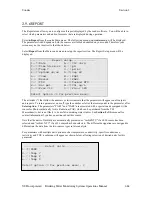
Sondes
Section
2
YSI Incorporated
Drinking Water Monitoring Systems Operations Manual
2-71
calibrated using solutions that contain 1 and 100 mg/L of NH
4
-N . Be certain that the calibration solution
and sensor are thermally equilibrated prior to entering NH
4
+
values.
To begin the calibration immerse the sonde in the 1 mg/L standard, press
Enter
, input the NH
4
-N value,
and again press
Enter.
The screen will display real-time readings that will allow you to determine when
the sensor has stabilized. Pressing
Enter
will confirm the first calibration. Following the instructions on
the screen, place the sonde in the second NH
4
+
standard, press
Enter
, input the correct concentration value,
again press
Enter
, and view the stabilization of the values on the screen in real time. After the readings
have stabilized, press
Enter
to confirm the calibration. Then, as instructed, press any key to return to the
Calibrate menu.
Select the
3-point
option to calibrate the NH
4
+
probe using three calibration solutions, two at ambient
temperature and one at a temperature significantly different from ambient. The 3-point calibration method
should be used to assure maximum accuracy when the temperature of the media to be monitored cannot be
anticipated. The procedure for this calibration is the same as for a 2-point calibration, but the software will
prompt you to place the sonde in the additional solution to complete the 3-point procedure. Be certain that
the calibration solution and sensor are thermally equilibrated prior to proceeding with the calibration. The
recommended order of calibration standards is (1) 100 mg/L standard at ambient temperature, (2) 1 mg/L
standard at ambient temperature, and (3) 1 mg/L standard at a different temperature (usually lower) than
ambient. For best results, insure a temperature difference of at least 10 C
°
between the two 1 mg/L
standards.
NOTE:
YSI strongly recommends the use of the 3-point protocol to ensure the best possible performance
from all ISE sensors (ammonium, nitrate, and chloride)
NITRATE
When selecting
7–ISE4 NO3
, you will be given the choice of 1-point, 2-point, or 3-point calibrations for
your nitrate (NO
3
-
) sensor. The procedure is identical to that for the ammonium sensor, except that the
calibrant values are in mg/L of NO
3
-N instead of NH
4
-N.
NOTE:
YSI strongly recommends the use of the 3-point protocol to ensure the best possible performance
from all ISE sensors (ammonium, nitrate, and chloride)
CHLORIDE
When selecting
8–ISE5-CL
-, you will be given the choice of 1-point, 2-point, or 3-point calibrations for
your chloride (Cl
-
) sensor. The procedure is identical to that for the ammonium sensor, except that the
calibrant values are in mg/L of Cl instead of NH
4
-N. IMPORTANT: We recommend that the user employ
standards for chloride that are 10 times greater than for ammonium and nitrate. Thus, the low calibration
value should be 10 mg/L and the high calibration value should be 1000 mg/L Cl-. The difference is due to
the fact that the effect of contamination of standards from inadvertent leakage of chloride ion from either
the free chlorine probe or the reference junction of the pH probe will be less significant at higher
concentrations.
NOTE:
YSI strongly recommends the use of the 3-point protocol to ensure the best possible performance
from all ISE sensors (ammonium, nitrate, and chloride)
OPTIC TURBIDITY






























